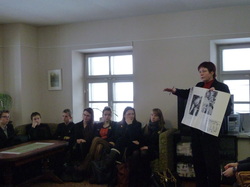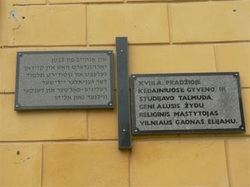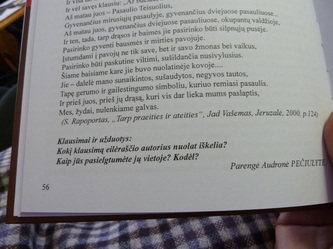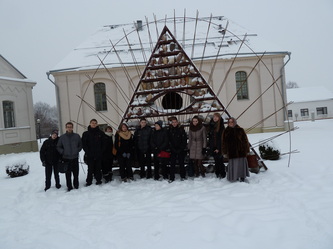Edukaciniai užsiėmimai daugiakultūriame centre/
Educational activities in multicultural center

Kėdainių "Atžalyno" I-II klasių gimnazistų grupės kartu su mokytojom Dalia ir Regina lankėsi Kėdainių daugiakultūriame centre ir klausėsi paskaitos apie Holokaustą(užsiėmimą vedė Audronė Pečiulytė), žiūrėjo filmą „Ambulance“, buvo atliekamos užduotys, vyko diskusija.
I-II class students from Kėdainiai Atzalynas gymnasium together with their teachers Dalia and Regina visited Kėdainiai multicultural center where they listened to a lecture on the Holocaust, presented by Audronė, watched the movie "Ambulance", performed some tasks, and participated in a discussion.
I-II class students from Kėdainiai Atzalynas gymnasium together with their teachers Dalia and Regina visited Kėdainiai multicultural center where they listened to a lecture on the Holocaust, presented by Audronė, watched the movie "Ambulance", performed some tasks, and participated in a discussion.
Edukacinė pamoka/Educational Lesson on PhotoPeach
Sinagogų kompleksas (XVII-XIX a.)/
The Complex of Synagogues

Senosios rinkos aikštėje yra dviejų sinagogų kompleksas. Viena jų - XVII a. pabaigą menanti halinė vasarinė sinagoga (1784 m. po gaisro perstatyta). Ji yra viena iš dviejų baroko stiliaus sinagogų Lietuvoje. Šioje sinagogoje studijavo žymus žydų mąstytojas Gaonas Elijahu. Kita XIX a. pradžioje pastatyta „mažoji“ sinagoga atliko ir mokymo funkcijas.
Nuo 2002 m. rugpjūčio 16 d. joje duris atvėrė Daugiakultūris centras, organizuojantis parodas, klasikinės muzikos koncertus, džiazo vakarus, konferencijas, seminarus, vykdantis edukacinę veiklą.
Kėdainiai Jewish community settled near the Old Market Square in the middle of the 17th C. Their religious community –Kahal – became one of the greatest and most famous in Samogitia. In the late 19th century there were 7 synagogues in Kėdainiai, but only three of them remain. A summer synagogue (17th C.) is in the Old Market Square (rebuilt in 1784, after the fire). It is one of two baroque style synagogues in Lithuania. A famous Jewish philosopher Gaon Elijahu studied there. Another synagogue, function also as a school, was built at the beginning of the 18th century. A Multicultural centre was opened in the Small Synagogue. This centre organizes exhibitions, concerts of classical music, jazz evenings, conferences, seminars, and educational activities.
http://www.visitkedainiai.lt
Nuo 2002 m. rugpjūčio 16 d. joje duris atvėrė Daugiakultūris centras, organizuojantis parodas, klasikinės muzikos koncertus, džiazo vakarus, konferencijas, seminarus, vykdantis edukacinę veiklą.
Kėdainiai Jewish community settled near the Old Market Square in the middle of the 17th C. Their religious community –Kahal – became one of the greatest and most famous in Samogitia. In the late 19th century there were 7 synagogues in Kėdainiai, but only three of them remain. A summer synagogue (17th C.) is in the Old Market Square (rebuilt in 1784, after the fire). It is one of two baroque style synagogues in Lithuania. A famous Jewish philosopher Gaon Elijahu studied there. Another synagogue, function also as a school, was built at the beginning of the 18th century. A Multicultural centre was opened in the Small Synagogue. This centre organizes exhibitions, concerts of classical music, jazz evenings, conferences, seminars, and educational activities.
http://www.visitkedainiai.lt
Žydų bendruomenė Kėdainiuose

Jewish Kėdainiai

Although a Jewish population is known to have existed in Kėdainiai (known to the Litvaks as Keydan) in the 15th century, no record of their activities at this time exists, and the fact that they were there at all is only evident because in 1495 all Jews were banished from the town. They appeared again around the middle of the 16th century (the banishment was repealed in 1503), from which time an extensive history is known. Early Jewish settlers were granted the right to produce beer and spirits in 1652, and also at one time had the monopoly on growing cucumbers. The Jewish contribution to Kėdainiai was by no means insubstantial, and the town gained recognition as a centre of Torah study, helped in part by the fact that the famous Gaon of Vilna, who married a local girl, studied there as a boy. On August 28, 1941, 710 Jewish men, 767 Jewish women and 599 Jewish children from the town were murdered by the Nazis and their willing local helpers, ending several hundred years of Jewish life in the town. Many Jewish buildings survived the Holocaust, notably but not exclusively the yellow wooden building close to Senoji Rinka where the Goan of Vilna studied and two surviving synagogues on Senoji Rinka itself, of which one now functions as a lively multicultural centre.

The Museum is a cultural institution very close to school and gives its special attention to an educational activity.
http://www.kedainiumuziejus.lt/Pub/default.aspx?Page=EducationalActivityEN
http://home.comcast.net/~acassel/keidan/exposition/
http://www.kedainiumuziejus.lt/Pub/default.aspx?Page=EducationalActivityEN
http://home.comcast.net/~acassel/keidan/exposition/























